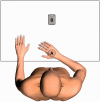Strong relations of elbow excursion and grip strength with post-stroke arm function and activities: Should we aim for this in technology-supported training?
- PMID: 31191944
- PMCID: PMC6453079
- DOI: 10.1177/2055668318779301
Strong relations of elbow excursion and grip strength with post-stroke arm function and activities: Should we aim for this in technology-supported training?
Abstract
Objective: To investigate the relationships between an extensive set of objective movement execution kinematics of the upper extremity and clinical outcome measures in chronic stroke patients: at baseline and after technology-supported training at home.
Methods: Twenty mildly to severely affected chronic stroke patients participated in the baseline evaluation, 15 were re-evaluated after six weeks of intensive technology-supported or conventional arm/hand training at home. Grip strength, 3D motion analysis of a reach and grasp task, and clinical scales (Fugl-Meyer assessment (FM), Action Research Arm Test (ARAT) and Motor Activity Log (MAL)) were assessed pre- and post-training.
Results: Most movement execution parameters showed moderate-to-strong relationships with FM and ARAT, and to a smaller degree with MAL. Elbow excursion explained the largest amount of variance in FM and ARAT, together with grip strength. The only strong association after training was found between changes in ARAT and improvements in hand opening (conventional) or grip strength (technology-supported).
Conclusions: Elbow excursion and grip strength showed strongest association with post-stroke arm function and activities. Improved functional ability after training at home was associated with increased hand function. Addressing both reaching and hand function are indicated as valuable targets for (technological) treatment applications to stimulate functional improvements after stroke.
Keywords: Stroke; clinical outcome measures; kinematics; reaching and grasping; recovery of function; upper extremity.
Conflict of interest statement
The author(s) declare no potential conflicts of interest with respect to the research, authorship, and/or publication of this article.
Figures




Similar articles
-
Effects of training with a passive hand orthosis and games at home in chronic stroke: a pilot randomised controlled trial.Clin Rehabil. 2017 Feb;31(2):207-216. doi: 10.1177/0269215516629722. Epub 2016 Jul 10. Clin Rehabil. 2017. PMID: 26869596 Clinical Trial.
-
Computer game-based upper extremity training in the home environment in stroke persons: a single subject design.J Neuroeng Rehabil. 2014 Mar 13;11:35. doi: 10.1186/1743-0003-11-35. J Neuroeng Rehabil. 2014. PMID: 24625289 Free PMC article. Clinical Trial.
-
Effects of robot-aided bilateral force-induced isokinetic arm training combined with conventional rehabilitation on arm motor function in patients with chronic stroke.Arch Phys Med Rehabil. 2007 Oct;88(10):1332-8. doi: 10.1016/j.apmr.2007.07.016. Arch Phys Med Rehabil. 2007. PMID: 17908578
-
Comparing Home Upper Extremity Activity with Clinical Evaluations of Arm Function in Chronic Stroke.Arch Rehabil Res Clin Transl. 2020 Jun 18;2(2):100048. doi: 10.1016/j.arrct.2020.100048. Arch Rehabil Res Clin Transl. 2020. PMID: 33336184 Free PMC article.
-
Affected arm use and cortical change in stroke patients exhibiting minimal hand movement.Neurorehabil Neural Repair. 2010 Feb;24(2):195-203. doi: 10.1177/1545968309360501. Neurorehabil Neural Repair. 2010. PMID: 20107135
Cited by
-
Correlation between kinetic and kinematic measures, clinical tests and subjective self-evaluation questionnaires of the affected upper limb in people after stroke.Front Neurosci. 2023 Dec 4;17:1264513. doi: 10.3389/fnins.2023.1264513. eCollection 2023. Front Neurosci. 2023. PMID: 38178833 Free PMC article.
-
Association of a kinematic measure of upper limb reaching and StartReact in chronic hemiparetic stroke.Exp Brain Res. 2025 May 6;243(6):139. doi: 10.1007/s00221-025-07047-2. Exp Brain Res. 2025. PMID: 40327088 Free PMC article.
-
Machine learning predicts clinically significant health related quality of life improvement after sensorimotor rehabilitation interventions in chronic stroke.Sci Rep. 2022 Jul 4;12(1):11235. doi: 10.1038/s41598-022-14986-1. Sci Rep. 2022. PMID: 35787657 Free PMC article.
-
Validity, reliability, and sensitivity to motor impairment severity of a multi-touch app designed to assess hand mobility, coordination, and function after stroke.J Neuroeng Rehabil. 2021 Apr 23;18(1):70. doi: 10.1186/s12984-021-00865-9. J Neuroeng Rehabil. 2021. PMID: 33892763 Free PMC article. Clinical Trial.
References
-
- Nichols-Larsen DS, Clark PC, Zeringue A, et al. Factors influencing stroke survivors' quality of life during subacute recovery. Stroke 2005; 36: 1480–1484. - PubMed
-
- Kitago T, Krakauer JW. Chapter 8 – motor learning principles for neurorehabilitation. In: Michael PB, David CG. (eds). Handbook of clinical neurology, New York: Elsevier, 2013, pp. 93–103. - PubMed
-
- Schaechter JD. Motor rehabilitation and brain plasticity after hemiparetic stroke. Progr Neurobiol 2004; 73: 61–72. - PubMed
-
- Kwakkel G. Impact of intensity of practice after stroke: issues for consideration. Disabil Rehabil 2006; 28: 823–830. - PubMed
LinkOut - more resources
Full Text Sources
Research Materials

